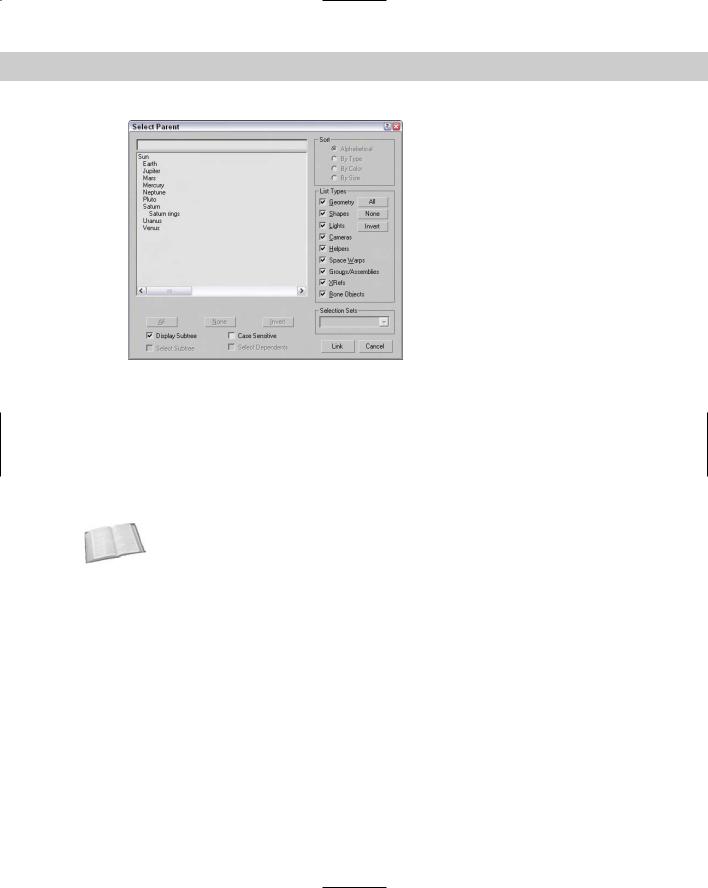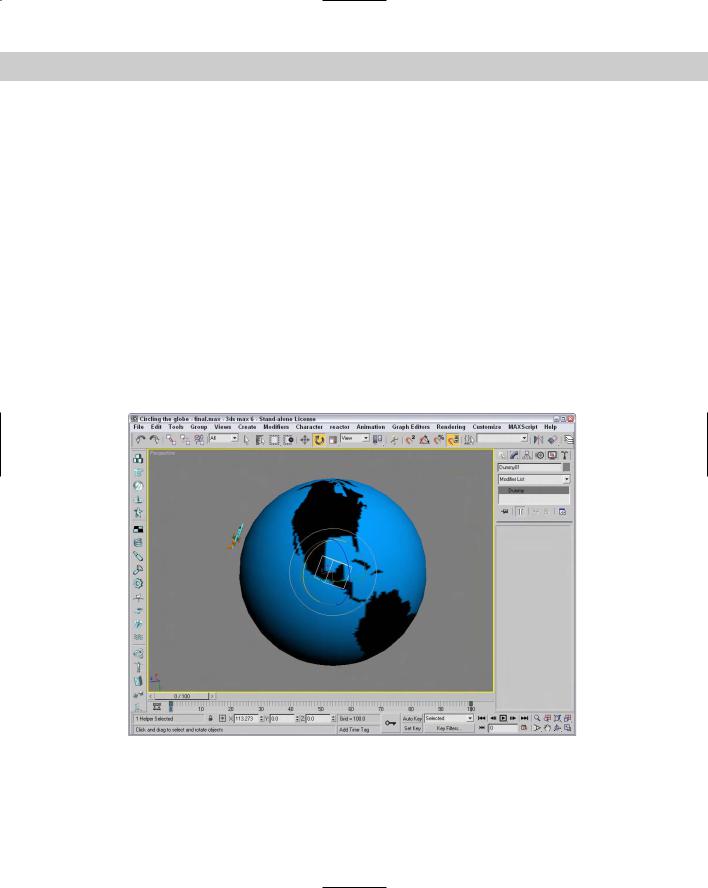
- •Preface
- •About This Book
- •Acknowledgments
- •Contents at a Glance
- •Contents
- •Relaxing at the Beach
- •Dressing the Scene
- •Animating Motion
- •Rendering the Final Animation
- •Summary
- •The Interface Elements
- •Using the Menus
- •Using the Toolbars
- •Using the Viewports
- •Using the Command Panel
- •Using the Lower Interface Bar Controls
- •Interacting with the Interface
- •Getting Help
- •Summary
- •Understanding 3D Space
- •Using the Viewport Navigation Controls
- •Configuring the Viewports
- •Working with Viewport Backgrounds
- •Summary
- •Working with Max Scene Files
- •Setting File Preferences
- •Importing and Exporting
- •Referencing External Objects
- •Using the File Utilities
- •Accessing File Information
- •Summary
- •Customizing Modify and Utility Panel Buttons
- •Working with Custom Interfaces
- •Configuring Paths
- •Selecting System Units
- •Setting Preferences
- •Summary
- •Creating Primitive Objects
- •Exploring the Primitive Object Types
- •Summary
- •Selecting Objects
- •Setting Object Properties
- •Hiding and Freezing Objects
- •Using Layers
- •Summary
- •Cloning Objects
- •Understanding Cloning Options
- •Mirroring Objects
- •Cloning over Time
- •Spacing Cloned Objects
- •Creating Arrays of Objects
- •Summary
- •Working with Groups
- •Building Assemblies
- •Building Links between Objects
- •Displaying Links and Hierarchies
- •Working with Linked Objects
- •Summary
- •Using the Schematic View Window
- •Working with Hierarchies
- •Setting Schematic View Preferences
- •Using List Views
- •Summary
- •Working with the Transformation Tools
- •Using Pivot Points
- •Using the Align Commands
- •Using Grids
- •Using Snap Options
- •Summary
- •Exploring the Modifier Stack
- •Exploring Modifier Types
- •Summary
- •Exploring the Modeling Types
- •Working with Subobjects
- •Modeling Helpers
- •Summary
- •Drawing in 2D
- •Editing Splines
- •Using Spline Modifiers
- •Summary
- •Creating Editable Mesh and Poly Objects
- •Editing Mesh Objects
- •Editing Poly Objects
- •Using Mesh Editing Modifiers
- •Summary
- •Introducing Patch Grids
- •Editing Patches
- •Using Modifiers on Patch Objects
- •Summary
- •Creating NURBS Curves and Surfaces
- •Editing NURBS
- •Working with NURBS
- •Summary
- •Morphing Objects
- •Creating Conform Objects
- •Creating a ShapeMerge Object
- •Creating a Terrain Object
- •Using the Mesher Object
- •Working with BlobMesh Objects
- •Creating a Scatter Object
- •Creating Connect Objects
- •Modeling with Boolean Objects
- •Creating a Loft Object
- •Summary
- •Understanding the Various Particle Systems
- •Creating a Particle System
- •Using the Spray and Snow Particle Systems
- •Using the Super Spray Particle System
- •Using the Blizzard Particle System
- •Using the PArray Particle System
- •Using the PCloud Particle System
- •Using Particle System Maps
- •Controlling Particles with Particle Flow
- •Summary
- •Understanding Material Properties
- •Working with the Material Editor
- •Using the Material/Map Browser
- •Using the Material/Map Navigator
- •Summary
- •Using the Standard Material
- •Using Shading Types
- •Accessing Other Parameters
- •Using External Tools
- •Summary
- •Using Compound Materials
- •Using Raytrace Materials
- •Using the Matte/Shadow Material
- •Using the DirectX 9 Shader
- •Applying Multiple Materials
- •Material Modifiers
- •Summary
- •Understanding Maps
- •Understanding Material Map Types
- •Using the Maps Rollout
- •Using the Map Path Utility
- •Using Map Instances
- •Summary
- •Mapping Modifiers
- •Using the Unwrap UVW modifier
- •Summary
- •Working with Cameras
- •Setting Camera Parameters
- •Summary
- •Using the Camera Tracker Utility
- •Summary
- •Using Multi-Pass Cameras
- •Creating Multi-Pass Camera Effects
- •Summary
- •Understanding the Basics of Lighting
- •Getting to Know the Light Types
- •Creating and Positioning Light Objects
- •Viewing a Scene from a Light
- •Altering Light Parameters
- •Working with Photometric Lights
- •Using the Sunlight and Daylight Systems
- •Using Volume Lights
- •Summary
- •Selecting Advanced Lighting
- •Using Local Advanced Lighting Settings
- •Tutorial: Excluding objects from light tracing
- •Summary
- •Understanding Radiosity
- •Using Local and Global Advanced Lighting Settings
- •Working with Advanced Lighting Materials
- •Using Lighting Analysis
- •Summary
- •Using the Time Controls
- •Working with Keys
- •Using the Track Bar
- •Viewing and Editing Key Values
- •Using the Motion Panel
- •Using Ghosting
- •Animating Objects
- •Working with Previews
- •Wiring Parameters
- •Animation Modifiers
- •Summary
- •Understanding Controller Types
- •Assigning Controllers
- •Setting Default Controllers
- •Examining the Various Controllers
- •Summary
- •Working with Expressions in Spinners
- •Understanding the Expression Controller Interface
- •Understanding Expression Elements
- •Using Expression Controllers
- •Summary
- •Learning the Track View Interface
- •Working with Keys
- •Editing Time
- •Editing Curves
- •Filtering Tracks
- •Working with Controllers
- •Synchronizing to a Sound Track
- •Summary
- •Understanding Your Character
- •Building Bodies
- •Summary
- •Building a Bones System
- •Using the Bone Tools
- •Using the Skin Modifier
- •Summary
- •Creating Characters
- •Working with Characters
- •Using Character Animation Techniques
- •Summary
- •Forward versus Inverse Kinematics
- •Creating an Inverse Kinematics System
- •Using the Various Inverse Kinematics Methods
- •Summary
- •Creating and Binding Space Warps
- •Understanding Space Warp Types
- •Combining Particle Systems with Space Warps
- •Summary
- •Understanding Dynamics
- •Using Dynamic Objects
- •Defining Dynamic Material Properties
- •Using Dynamic Space Warps
- •Using the Dynamics Utility
- •Using the Flex Modifier
- •Summary
- •Using reactor
- •Using reactor Collections
- •Creating reactor Objects
- •Calculating and Previewing a Simulation
- •Constraining Objects
- •reactor Troubleshooting
- •Summary
- •Understanding the Max Renderers
- •Previewing with ActiveShade
- •Render Parameters
- •Rendering Preferences
- •Creating VUE Files
- •Using the Rendered Frame Window
- •Using the RAM Player
- •Reviewing the Render Types
- •Using Command-Line Rendering
- •Creating Panoramic Images
- •Getting Printer Help
- •Creating an Environment
- •Summary
- •Creating Atmospheric Effects
- •Using the Fire Effect
- •Using the Fog Effect
- •Summary
- •Using Render Elements
- •Adding Render Effects
- •Creating Lens Effects
- •Using Other Render Effects
- •Summary
- •Using Raytrace Materials
- •Using a Raytrace Map
- •Enabling mental ray
- •Summary
- •Understanding Network Rendering
- •Network Requirements
- •Setting up a Network Rendering System
- •Starting the Network Rendering System
- •Configuring the Network Manager and Servers
- •Logging Errors
- •Using the Monitor
- •Setting up Batch Rendering
- •Summary
- •Compositing with Photoshop
- •Video Editing with Premiere
- •Video Compositing with After Effects
- •Introducing Combustion
- •Using Other Compositing Solutions
- •Summary
- •Completing Post-Production with the Video Post Interface
- •Working with Sequences
- •Adding and Editing Events
- •Working with Ranges
- •Working with Lens Effects Filters
- •Summary
- •What Is MAXScript?
- •MAXScript Tools
- •Setting MAXScript Preferences
- •Types of Scripts
- •Writing Your Own MAXScripts
- •Learning the Visual MAXScript Editor Interface
- •Laying Out a Rollout
- •Summary
- •Working with Plug-Ins
- •Locating Plug-Ins
- •Summary
- •Low-Res Modeling
- •Using Channels
- •Using Vertex Colors
- •Rendering to a Texture
- •Summary
- •Max and Architecture
- •Using AEC Objects
- •Using Architectural materials
- •Summary
- •Tutorial: Creating Icy Geometry with BlobMesh
- •Tutorial: Using Caustic Photons to Create a Disco Ball
- •Summary
- •mental ray Rendering System
- •Particle Flow
- •reactor 2.0
- •Schematic View
- •BlobMesh
- •Spline and Patch Features
- •Import and Export
- •Shell Modifier
- •Vertex Paint and Channel Info
- •Architectural Primitives and Materials
- •Minor Improvements
- •Choosing an Operating System
- •Hardware Requirements
- •Installing 3ds max 6
- •Authorizing the Software
- •Setting the Display Driver
- •Updating Max
- •Moving Max to Another Computer
- •Using Keyboard Shortcuts
- •Using the Hotkey Map
- •Main Interface Shortcuts
- •Dialog Box Shortcuts
- •Miscellaneous Shortcuts
- •System Requirements
- •Using the CDs with Windows
- •What’s on the CDs
- •Troubleshooting
- •Index

Chapter 8 Grouping and Linking Objects 245
Figure 8-7: The Select Parent dialog box indents all child objects under their parent.
The Schematic View (opened with the Graph Editors New Schematic View menu command) presents a graph in which objects are represented by rectangles with their hierarchical links drawn as lines running between them. The Schematic View window is covered in the next chapter.
The Track View (opened with the Graph Editors New Track View menu command) displays lots of scene details in addition to the object hierarchy. In the Track View, you can easily expand and contract the hierarchy to focus on just the section you want to see or select.
Cross- |
For more information on using the Track View, see Chapter 33, “Working with the Track View.” |
Reference |
|
Working with Linked Objects
If you link some objects together and set some animation keys, and the magical Play button starts sending objects hurtling off into space, chances are good that you have a linked object that you didn’t know about. Understanding object hierarchies and being able to transform those hierarchies are the keys to efficient animation sequences.
All transformations are done about an object’s pivot point. You can move and reorient these pivot points as needed by clicking the Pivot button under the Hierarchy panel.

246 Part II Working with Objects
Several additional settings for controlling links are available under the Hierarchy panel of the Command Panel (the Hierarchy panel tab looks like a mini-organizational chart). Just click the Link Info button. This button opens two rollouts if a linked object is selected. You can use the Locks and Inherit rollouts to limit an object’s transformations and specify the transformations that it inherits.
Cross- |
I present more information on object transformations in Chapter 10, “Transforming Objects — |
Reference |
Translate, Rotate, and Scale.” |
|
Selecting hierarchies
You need to select a hierarchy before you can transform it, and you have several ways to do so. The easiest method is to simply double-click an object. Double-clicking the root object selects the entire hierarchy, and double-clicking an object within the hierarchy selects it and all of its children.
After you select an object in a hierarchy, pressing the Page Up or Page Down keyboard shortcut selects its parent or child objects. For example, if you select the Sun object and press Page Down, all planet objects are selected and the Sun object is deselected. Selecting any of the planet objects and pressing Page Up selects the Sun object.
Linking to dummies
Dummy objects are useful as root objects for controlling the motion of hierarchies. By linking the parent object of a hierarchy to a dummy object, you can control all the objects by moving the dummy.
To create a dummy object, select Create Helpers Dummy, or open the Create panel and click the Helpers category button (this button looks like a small tape measure) and select the Standard category. Within the Object Type rollout is the Dummy button; click it, and then click in the viewport where you want the dummy object to be positioned. Dummy objects look like wireframe box objects in the viewports, but dummy objects are not rendered.
Tutorial: Circling the globe
When you work with complex models with lots of parts, you can control the object more easily if you link it to a Dummy object and then animate the dummy object instead of the entire model. To practice doing this, we create a simple animation of an airplane flying around the globe. To perform this feat, we create a dummy object in the center of a sphere, link the airplane model to it, and rotate the dummy object. This tutorial involves transforming and animating objects, which are covered in later chapters.
Cross- |
Rotating objects is covered in Chapter 10, “Transforming Objects — Translate, Rotate, and |
Reference |
Scale,” and the basics of animation are covered in Chapter 30, “Animation Basics.” |
|
To link and rotate objects using a dummy object, follow these steps:
1.Open the Circling the globe.max file found in the Chap 08 directory on the CD-ROM.
This file includes a transparent wireframe sphere with an airplane model positioned above it. The airplane model was created by Viewpoint Datalabs.

Chapter 8 Grouping and Linking Objects 247
2.Select Create Helpers Dummy, and then drag in the center of the Sphere to create a Dummy object.
3.Because the dummy objects is inside the sphere, creating the link between the airplane and the dummy object can be difficult. To simplify this process, select and right-click the sphere object, and then select Hide Selection from the pop-up menu.
This hides the sphere so that you can create a link between the airplane and the dummy object.
4.Click the Link button on the main toolbar, and drag a line from the airplane to the dummy object.
5.Click the Auto Key button (or press N) to enable animation key mode, and drag the Time Slider to frame 100. Then click the Select and Rotate button on the main toolbar (or press E), and select the dummy object. Then rotate the dummy object, and notice how the linked airplane also rotates over the surface of the sphere.
6.Select the dummy object, and right click to access the pop-up quadmenu. Then select the Unhide All menu command to make the sphere visible again.
By linking the airplane to a dummy object, you don’t have to worry about moving the airplane’s pivot point to get the correct motion. Figure 8-8 shows a frame from the final scene.
Figure 8-8: With a link to a dummy object, making the airplane circle the globe is easy.

248 Part II Working with Objects
Summary
As scenes become more complex, the name of the game is organization. You can organize objects within the scene in several ways, including grouping, linking, and building hierarchies.
In this chapter, you’ve done the following:
Grouped objects using the Group menu and learned to work with groups
Learned about parent, child, and root relationships
Created a hierarchy of objects using the Link and Unlink features
Viewed links in the viewport
Learned how to create and use dummy objects
In the next chapter, you learn how to use an interface that helps as you organize scenes of objects — the Schematic View window.
|
|
|
